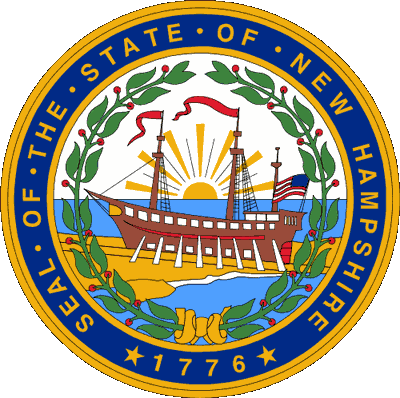- » 50 States
- » Histories
- » State Symbols
- » Seals
New Hampshire State Seal
Great Seal of the State of New Hampshire

Adopted in 1931.
The State of New Hampshire has held two seals since it declared its independence from Great Britain on January 5, 1776. While both seals have been retained, most people are only familiar with the Great Seal due to its corporate use.
The seal was first created in 1775 by the First Provincial Congress. The second Great Seal for the state of New Hampshire was adopted in 1931.
New Hampshire has had a state seal for more than 200 years, but its present form is only 50 years old.
New Hampshire Great Seal
The seal was first created in 1775 by the First Provincial Congress. It comprised a pine tree and an upright fish, on each side of a bundle of five arrows. The design reflected the state's then two major economic resources, and the arrows symbolized the strength of unity among the then five counties.
When the present state constitution became effective in 1784, the new Legislature revised the seal, to depict a ship on stocks, with a rising sun in the background, to reflect Portsmouth having become a major shipbuilding center during the war years. Various items for shipment were also shown on a frontal dock.
Details of this 1784 seal became so distorted in the ensuing century and a half that the 1931 Legislature voted major improvements, and, or the first time, spelled out its makeup. Director Otis G. Hammond of the New Hampshire Historical Society sparked this adjustment, by reporting that artists and sketchers had injected surprising details into the seal, as they produced new dies every few years for official state use. They produced rum barrels on the dock, and, on occasion, even human beings beside them.
When Governor John G. Winant of Concord launched a second term in 1931, he named a committee to serve with Hammond, to produce a less objectionable seal. The 1931 Legislature readily approved its recommendations.
Historic Warship Honored. The frigate Raleigh, built at Portsmouth in 1776, as one of the first 13 warships sponsored by the Continental Congress for a new American navy, became the centerpiece of the 1931 seal. The figure 1784 on the old seal was changed to 1776. The old Latin phrase "Neo Hantoniensis 1784 Sigillum Republica" around the circular seal was replaced with "Seal of the state of New Hampshire 1776." The 1931 seal law spelled out that only a granite boulder could be shown in the foreground, as symbolic of the Granite State's rugged terrain and the character of its citizenry.
The Raleigh has a checkered career of adversities, while becoming the first to carry the American flag into sea battle. She was unable to go to sea for 15 months for lack of armament, and after her first voyage to France for munitions, her captain was dismissed for incompentency. Soon thereafter she was beached off Maine, captured by British warships, and used for the remainder of the Revolutionary War against her own country.
Captain John F. Rowe (USN retired) of Newington resurrected the life and lore of the Raleigh in recent years. The British liked the sturdiness of the frigate so much that they sketched its construction details, to build others like it, and Captain Rowe obtained the drawings from London, to enable him to paint the Raleigh in all its pristine glory. And when Governor Hugh J. Gallen and his Executive Council celebrated the 300th anniversary of New Hampshire's state government, Publisher William Loeb of the Union Leader and New Hampshire Sunday News purchased an enlarged portrait of the Raleigh, by Captain Rowe, and presented it to the state for permanent display in the State House.
New Hampshire Revised Statutes Annotated (RSA) 3:9
Anderson, Leon. History. Manual for the General Court 1981.
State Seal Law of 1931
The 1931 State Seal law placed the frigate Raleigh as the centerpiece of the new seal. The Raleigh was built in Portsmouth in 1776, as one of the first 13 warships sponsored by the Continental Congress for a new American navy. The law declared the seal to be 2 inches in diameter bearing the new inscription, SEAL • OF • THE • STATE • OF • NEW HAMPSHIRE, replacing the Latin phrase Sigillum Republica Neo Hantoniensis. The law also declared that only a granite boulder could be shown in the foreground.
New Hampshire Statutes
TITLE I
THE STATE AND ITS GOVERNMENT
CHAPTER 3
STATE EMBLEMS, FLAG, ETC.
Section 3:9
3:9 State Seal. - The seal of the state shall be 2 inches in diameter, circular, with the following detail and no other: A field crossed by a straight
horizon line of the sea, above the center of the field; concentric with the field the rising sun, exposed above the horizon about 1/3 of its diameter;
the field encompassed with laurel; across the field for the full width within the laurel a broadside view of the frigate Raleigh, on the stocks; the
ship's bow dexter and higher than the stern; the 3 lower masts shown in place, together with the fore, main and mizzen tops, shrouds and mainstays;
an ensign staff at the stern flies the United States flag authorized by act of Congress June 14, 1777; a jury staff on the mainmast and another on
the foremast each flies a pennant; flags and pennants are streaming to the dexter side; the hull is shown without a rudder; below the ship the field
is divided into land and water by a double diagonal line whose highest point is sinister; no detail is shown anywhere on the water, nor any on the
land between the water and the stocks except a granite boulder on the dexter side; encircling the field is the inscription, SEAL • OF •
THE • STATE • OF • NEW HAMPSHIRE, the words separated by round periods, except between the parts of New Hampshire; at the lowest
point of the inscription is the date 1776, flanked on either side by a 5-pointed star, which group separates the beginning and end of the inscription;
the whole form and design to be as follows: Image)
Source. RS 11:1. CS 11:1. GS 13:2. GL 14:2. PS 15:6. PL 8:4. 1931, 133:2. RL 13:4.
Section 3:9-a
3:9-a Unauthorized Use Prohibited. - The state seal shall be the property of the state of New Hampshire. No person shall manufacture, sell, expose
for sale, or have in possession for sale any article or substance, being an article of merchandise or receptacle of merchandise or article or thing
for carrying or transporting merchandise, or sell, expose for sale, give away, or have in possession for sale or to give away or for any purpose any
article or thing to advertise or promote services, upon which shall have been printed, painted, attached, or otherwise placed a representation or likeness
of the state seal, provided, however, that upon application, the secretary of state may authorize the use of the state seal. Once such approval is
given, such use shall be exempt from the provisions of this section until or unless such approval is revoked or suspended by the secretary of state.
Source. 1971, 236:1. 1995, 72:1, eff. July 8, 1995.
Section 3:9-b
3:9-b Penalty. - Whoever violates the provisions of RSA 3:9-a shall be guilty of a misdemeanor if a natural person, or guilty of a felony if any other
person.
Source. 1971, 236:1. 1973, 528:2, eff. Oct. 31, 1973 at 11:59 p.m.
Section 3:9-c
3:9-c Injunction. - Whenever the attorney general is aware of a violation of the provisions of RSA 3:9-a, the attorney general may bring an action
in the name of the state to enjoin distribution of any articles or things upon which a representation or likeness of the state seal has been placed.
Source. 1971, 236:1. 1995, 72:2, eff. July 8, 1995.








